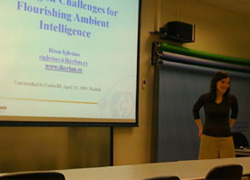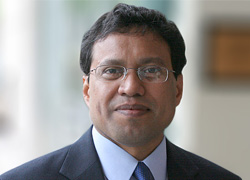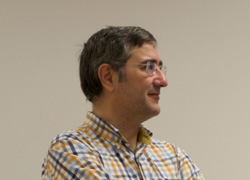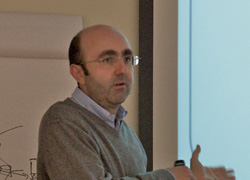IMDEA Networks

Event Category: External Presentation (External Speaker)
Innovating the Multi-Provider Internet
With the Internet offering a single best-effort service, there have been numerous proposals of diversified network services that align better with the divergent needs of different distributed applications. The failure of these innovative architectures to gain wide deployment is primarily due to economic and legacy issues, rather than technical shortcomings. We propose a new paradigm for network service differentiation where design principles account explicitly for the multiplicity of Internet service providers and users as well as their economic interests in environments with partly deployed new services. Our key idea is to base the service differentiation on performance itself, rather than price.
Read more arrow_right_altOptimization, Pricing and Control in Networks
In the last decade, a new theoretical foundation for quantitative network research has emerged. Its key ingredients are the following: economic models to formulate network resource allocation as a convex optimization problem; use of optimization methods to devise decentralized solutions to these problems, in terms of dynamic adaptation of the relevant variables; tools of control theory to understand the dynamic properties of these methods. The resulting body of theory has been highly successful in providing models for TCP congestion control, describing how local protocols should be designed to allow for interesting global properties to emerge. From here, recent research has advanced this methodology to other layers of the protocol stack. In this course we will provide an introduction to this interdisciplinary field of research.
Read more arrow_right_altLoad Balancing is Not Optimal in Wireless Systems With Dynamic Interference
We study the impact of policies to associate users with base stations/access points on flow-level performance in interference limited wireless networks.
Most research in this area has used static interference models (i.e., neighboring base stations are always active) and resorted to intuitive objectives such as load balancing. In this paper, we show that this can be counter productive, and that asymmetries in load can lead to significantly better performance in the presence of dynamic interference which couples the transmission rates experienced by users at various base stations. We propose a methodology that can be used to optimize the performance of a class of coupled systems, and apply it to study the user association problem. We show that by properly inducing load asymmetries, substantial performance gains can be achieved relative to a load balancing policy (e.g., 15 times reduction in mean delay). We present a novel measurement based, interference-aware association policy that infers the degree of interference induced coupling and adapts to it.
ClubADSL
"ADSL is becoming the standard form of residential and small-business broadband access to the Internet due, primarily, to its low deployment cost. These ADSL residential lines are often deployed with Access Points (AP) that provide wireless connectivity. While the ADSL technology has showed evident limits in terms of capacity, the short-range wireless communication can guarantee a similar or higher capacity. Even more important, it is often possible for a residential wireless client to be in range of several other APs belonging to nearby neighbors with ADSL connections. We introduce ClubADSL, a prototype wireless station that can connect to several multi-frequency APs in range and aggregate their available ADSL bandwidth. ClubADSL achieves a fair bandwidth among the concurrent stations and minimizes the impact of end-to-end latency on the system performance. We show the feasibility of such a system in seamlessly transmitting TCP traffic, and validate its experimental implementation over commodity hardware in controlled scenarios."
Read more arrow_right_altBetting on Challenges for Flourishing Ambient Intelligence
This talk will present a brief overview of systems, technologies and applications that are part of Ambient Intelligence (AmI). It is also the purpose of this talk to bring together researchers for inspiring innovation in the evolution of AmI and for answering the question: What are the challenges we need to bet on?
Read more arrow_right_altWireless Mesh Networks: QuRiNet Testbed and Related Research
Wireless mesh networks are becoming popular alternatives to wireless LANs and for cost-effective use in varied application environments. There are several technical challenges that must be addressed for mesh networking to be as effective as any other form of broadband networking. Much of these challenges relate to multi-hop wireless communication and limited capacity. The goal of this informal presentation is to facilitate further discussions on these challenges.
Read more arrow_right_altMonitoring and Managing the Quality of Service in Structured Peer-to-Peer Systems
The peer-to-peer paradigm shows the potential to provide the same functionality like client/server based systems, but with much lower costs.
One substantial limitation of p2p systems are missing guarantees on the quality of service, as the whole infrastructure is based on unreliable peers. In order to control the quality of peer-to-peer systems, monitoring and management mechanisms need to be applied. Both tasks are challenging in large-scale networks with autonomous, unreliable nodes.
Read more arrow_right_altRouting for Energy Minimization in the Speed Scaling Model
The problem is interesting for two reasons. First, the cost function closely models the energy consumption of some network elements and network-wide optimization is a well-motivated but under-explored direction for energy minimization. Second, it brings light to a challenging combinatorial optimization problem. We will present positive and negative results for polynomial functions and polynomial functions with startup cost. For the latter, techniques to accomplish better-than-polynomial approximation ratios independent of demands and cost function remains a challenging problem.
Read more arrow_right_altEnergy Efficient Ethernet (IEEE 802.3az): Performance Evaluation
Energy consumption in Computer Networks is an issue that is gaining increasing attention. In this talk we will review the issue of energy consumption in Computer Networks to then focus on Ethernet where a new standard is being developed to improve energy efficiency. We will discuss some of the alternatives that were considered during the Energy Efficient Ethernet standardization process and describe the solution adopted in the standard. Then we will present some results of an initial performance evaluation of the standard that shows the potential savings for different scenarios. We will conclude the talk by outlining the implications that Energy Efficient Ethernet will have on different aspects of the LANs.
Read more arrow_right_altSecurity and non-cooperative behavior in wireless networks
According to most technology pundits, progress in wireless and sensor networks will lead us into a world of ubiquitous computing, in which myriads of tiny, untethered sensors and actuators will communicate with each other. Information technology will thus deliver its most encompassing and pervasive accomplishment to mankind, promptly taking care of the needs and wishes of everyone.
Read more arrow_right_alt











Recent Comments